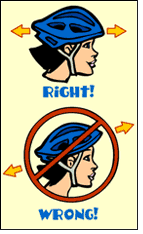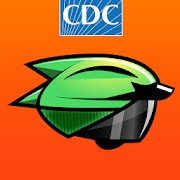
Helmet Safety

When you ride a skateboard or bike, always wear a helmet to keep your head and brain safe.
Your helmet should fit properly and be:
- Well taken care of
- Age and size appropriate
- Worn consistently and correctly
- Appropriately certified for use
While there is no concussion-proof helmet, a helmet can help protect you from a serious brain or head injury. Even with a helmet, it’s important for you to avoid hits to the head.
Click here to learn more about concussions.
3-2-1 Blast Off! CDC’s Injury Center has developed the CDC HEADS UP Rocket Blades mobile game app on concussion safety for children aged 6 to 8. Through a futuristic world of galactic racing adventures children can learn the benefits of playing it safe and smart!
Your helmet should:
- Sit flat on your head — make sure it’s level and isn’t tilted back or forward.
- The front of the helmet should sit low — about two finger widths above your eyebrows to protect your forehead.
- The straps on each side of your head should form a “Y” over your ears, with one part of the strap in front of your ear, and one behind — just below your earlobes.
- If the helmet leans forward, adjust the rear straps. If it tilts backward, tighten the front straps.
- Buckle the chinstrap securely at your throat so that the helmet feels snug on your head and doesn’t wiggle up and down or from side to side.
For more information and resources on this check out HEADS UP.
Make sure your child helmet fits right by following these tips and guidelines in this helpful video.
- Many kids think helmets just aren’t cool. Who says helmets can’t be cool? If you’re shopping for a helmet, there are lots of options, so you can pick out your favorite color. Or decorate your helmet with stickers and reflectors to show your personal style. Helmets are designed to help prevent injuries to your head. A serious fall or crash can cause permanent brain damage or death and that’s definitely not cool.
- Today’s helmets are lightweight, well ventilated, and have lots of padding. So, for those of you who think helmets just can’t be comfortable, try one on to make sure it fits properly and comfortably on your head before you buy it.
- Another myth about helmets is that really good riders don’t need to wear one. False! Bike crashes or collisions can happen at any time. Even professional bike racers get in serious wrecks. In three out of four bike crashes, bikers usually get some sort of injury to their head.












